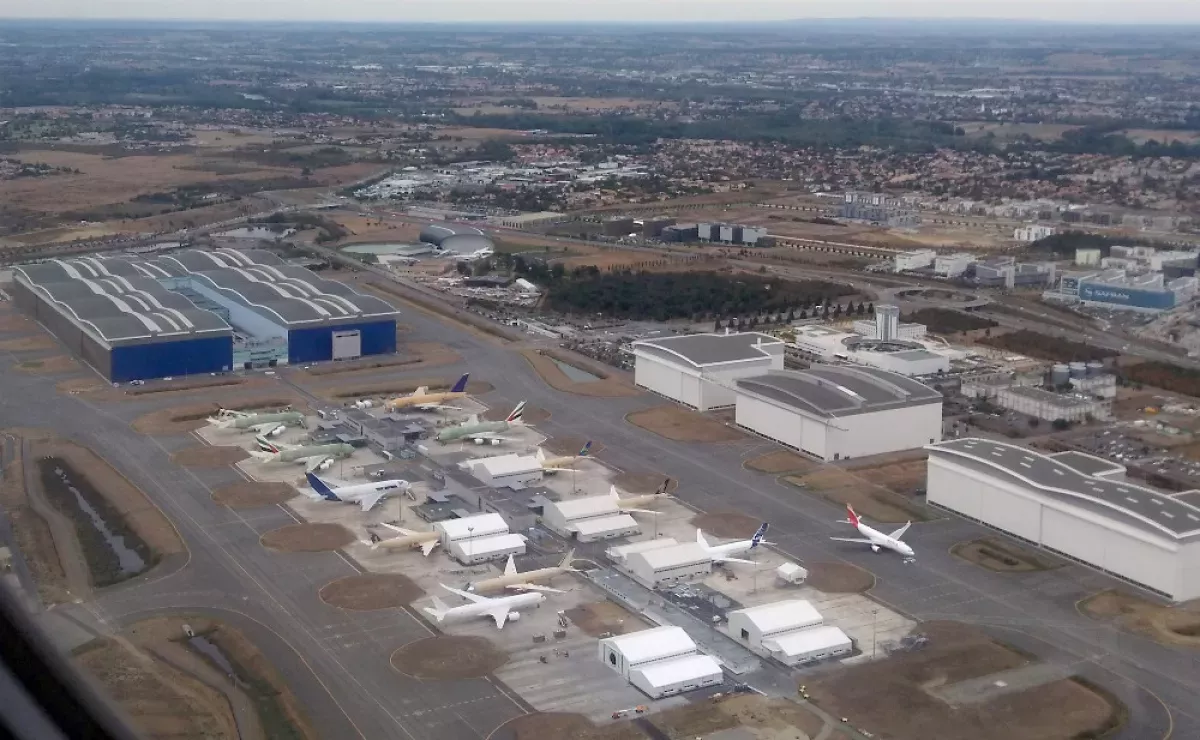Airbus SE is a multinational aerospace company headquartered in Europe. They are best known for designing and manufacturing commercial aircraft, holding the title of world's largest airliner manufacturer since 2019. Apart from commercial aircraft, Airbus also operates in the defense, space, and helicopter sectors, with a leading position in helicopter manufacturing.
1922: Establishment of Dornier Flugzeugwerke
Dornier Flugzeugwerke was established in 1922.
1923: Establishment of CASA (Construcciones Aeronáuticas SA)
CASA (Construcciones Aeronáuticas SA) was established in 1923.
1926: Establishment of Daimler-Benz Aerospace Unit
Daimler-Benz established its aerospace unit in 1926.
1937: Establishment of Matra
Matra was established in 1937.
1968: Establishment of Messerschmitt-Bölkow-Blohm (MBB)
Messerschmitt-Bölkow-Blohm (MBB) was established in 1968.
1970: Establishment of Airbus Industrie GIE
Airbus Industrie GIE, a consortium of European aerospace companies, was established in 1970 to compete with American aircraft manufacturers.
1970: Establishment of Aérospatiale
Aérospatiale was established in 1970.
1972: Airbus Launches the A300, the First Wide-Body Twinjet
Airbus made its mark on the aviation industry in 1972 with the introduction of the A300, the world's first wide-body, twin-engine aircraft.
1976: ETOPS 90 Rule Benefits A300 Operations
The introduction of the ETOPS 90 rule in 1976, which extended the allowable operating time for twinjet aircraft away from airports, significantly enhanced the efficiency of the A300 on transatlantic and other long-haul routes.
1982: Introduction of the Airbus A310
Airbus introduced the A310 in 1982, a shorter and modified version of the A300, further expanding its product line.
1986: New Rules Extend Twinjet Operations, Impacting A340 Sales
New regulations introduced in 1986 extended the allowable operating time for twinjet aircraft, impacting the sales of the four-engine A340.
1987: Launch of the Airbus A320 and its Digital Fly-by-Wire System
The year 1987 saw the launch of the Airbus A320, a narrow-body aircraft that became a major commercial success and pioneered the use of a digital fly-by-wire control system in commercial aviation.
1989: Further Extension of Twinjet Operations Benefits A330
The continued extension of twinjet operating regulations in 1989 further benefited the A330, solidifying its position in the market.
1991: Introduction of the Airbus A340
Airbus expanded its wide-body offerings in 1991 with the introduction of the four-engine A340, designed for long-haul routes.
1992: Airbus Highlights US Government Support for Boeing
Airbus argues that Boeing, its main competitor, receives significant support from the US government, potentially contradicting the 1992 EU-US agreement. This support includes military contracts, NASA technology funding, and tax breaks. Some argue that this assistance violates the agreement and WTO rules. Airbus points to examples like the Boeing KC-767 military contract and state and local government support for the Boeing 787 as evidence of unfair advantages.
1992: Establishment of Eurocopter SA
Eurocopter SA, a subsidiary of EADS, was established in 1992.
1992: EU-US Agreement on Large Civil Aircraft Support
In 1992, the European Union and the United States established an agreement to address concerns about government support for large civil aircraft manufacturers. This agreement aimed to create a level playing field for companies like Airbus and Boeing by setting limits on government subsidies and loans.
1992: Formation of Eurocopter Group
The Eurocopter Group, which would later become Airbus Helicopters, was founded in 1992 through a merger of Aérospatiale and DASA's helicopter divisions.
1992: Launch of the Airbus A330 Twinjet
The year 1992 marked the debut of the Airbus A330, a twin-engine wide-body aircraft that would become a mainstay in the industry.
1993: Introduction of the Airbus A321
Building on the success of the A320, Airbus introduced a lengthened version, the A321, in 1993.
1995: Launch of the Airbus A319
Airbus further expanded its narrow-body family in 1995 with the launch of the shorter A319.
1997: Airbus Enters the Business Jet Market with the A319 Corporate Jet
Following the success of Boeing's business jet offerings, Airbus made its foray into the business jet market in 1997 with the introduction of the A319 Corporate Jet.
2000: Airbus Shares Listed on Stock Exchanges
Following its formation in 2000, Airbus shares were listed on major stock exchanges, including Paris, Frankfurt, and four regional Spanish exchanges.
2000: EADS Introduces New Logo After Merger
Following the merger in 2000, EADS introduced a new logo combining elements from DaimlerChrysler Aerospace AG and Aérospatiale-Matra.
2000: Establishment of European Aeronautic Defence and Space Company (EADS) NV
The European Aeronautic Defence and Space Company (EADS) NV was established in 2000.
2000: Formation of EADS
The European Aeronautic Defence and Space Company (EADS) was founded in 2000 through a merger of Aérospatiale-Matra, DASA, and CASA.
2001: Reorganization of Airbus Industrie GIE as Airbus SAS
In 2001, Airbus Industrie GIE was reorganized into Airbus SAS, a simplified joint-stock company.
2002: Airbus Introduces the A318
The Airbus A318, an even shorter variant of the A320 family, entered service in 2002.
March 2003: South Africa Drops Bribery Charges Against EADS Executive
In March 2003, South Africa withdrew bribery charges against the former head of EADS South Africa. This decision came amidst a wider corruption scandal related to a major arms deal. Allegations had surfaced that Airbus, then part of EADS, was involved in offering bribes to secure the deal.
2003: Airbus in North America
In 2003, US contractors earned an estimated $5.5 billion supporting Airbus, representing a significant portion of Airbus's global supply chain.
July 2004: Boeing Accuses Airbus of Abusing EU-US Agreement on Government Support
In July 2004, former Boeing CEO Harry Stonecipher accused Airbus of violating a 1992 agreement between the European Union and the United States. This agreement aimed to regulate government support for large civil aircraft manufacturers. Stonecipher alleged that Airbus was improperly benefiting from "launch aid" in the form of reimbursable launch investments (RLI) provided by European governments. Airbus maintained that its financing arrangements complied with the agreement and World Trade Organization (WTO) rules.
September 2004: South Africa Dismisses Bribery Charges Against Tony Yengeni
In September 2004, South African prosecutors dismissed bribery charges against Tony Yengeni, the former chief whip of the country's ruling party, the African National Congress. Yengeni had been accused of accepting bribes from companies, including Airbus, during a controversial arms deal in the late 1990s. The dismissal of these charges marked a significant development in the long-running scandal.
January 2005: EU and US Trade Representatives Initiate Talks to Resolve Airbus-Boeing Dispute
In January 2005, Peter Mandelson, representing the European Union, and Robert Zoellick, representing the United States, agreed to begin negotiations in an attempt to resolve the escalating trade dispute between Airbus and Boeing. However, these talks proved unsuccessful in finding a resolution, and the conflict continued to intensify.
October 2005: UK Warns Against Political Interference in EADS
In October 2005, the UK Ministry of Defence cautioned European politicians against interfering in the corporate governance of EADS, threatening to withhold future contracts.
November 2005: Airbus Executives Exercise Stock Options Amidst A380 Delays
In November 2005, several Airbus executives, including Noël Forgeard, exercised their stock options. This action later came under scrutiny after the announcement of significant delays in the Airbus A380 project in June 2006. Investigators examined whether these executives had prior knowledge of the delays when they exercised their options, potentially constituting insider trading.
2005: Airbus Unveils the A380 Superjumbo
Airbus made history in 2005 with the introduction of the A380, a double-decker, four-engine aircraft designed to challenge the Boeing 747 in the long-haul market.
2005: Norwegian Pension Fund Excludes EADS Over Cluster Bomb Concerns
In 2005, the Government Pension Fund of Norway made a decision to exclude several companies, including EADS (Airbus's parent company) and EADS Finance BV, from its investment portfolio. The fund cited concerns about these companies' involvement in the production of cluster bombs or their components. Specifically, the criticism targeted TDA, a joint venture between EADS and Thales S.A., which manufactured the PR Cargo mortar ammunition. This ammunition was considered by some to be a form of cluster munition.
March 2006: Airbus Executives Exercise Stock Options, Raising Insider Trading Concerns
In March 2006, similar to the previous November, several Airbus executives, including Noël Forgeard, again exercised stock options. This action, coming just a few months before the public announcement of A380 delivery delays, further fueled suspicions of insider trading. French authorities launched an investigation to determine whether these executives had acted improperly based on inside information about the project's problems.
April 2006: DaimlerChrysler Announces Reduction in EADS Shareholding
DaimlerChrysler announced its plan to reduce its stake in EADS from 30% to 22.5% in April 2006, leading to an imbalance in German and French shareholdings.
April 2006: French Government's Intervention in EADS Raises Concerns
In April 2006, the French government, through its state-owned bank Caisse des Dépots et Consignations (CDC), purchased a portion of Lagardère's 7.5% stake in EADS, the parent company of Airbus. This move was controversial as it occurred shortly before the June 2006 announcement of A380 delivery delays and the subsequent drop in EADS's share price. Critics argued that the government's intervention might have been intended to mitigate potential losses for Lagardère, raising concerns about transparency and potential conflicts of interest.
April 2006: Norwegian Pension Fund Reinstates EADS After Cluster Bomb Concerns Resolved
In April 2006, the Government Pension Fund of Norway reversed its previous decision and declared that EADS no longer met the criteria for exclusion based on the production of cluster munitions. EADS had successfully argued that its products did not fall under the definition of antipersonnel mines as outlined in the Ottawa Treaty. However, the fund continued to exclude EADS due to its indirect involvement in nuclear weapons production through its shareholding in MBDA.
June 2006: Airbus CEO and Co-CEO Resign Amidst A380 Delivery Delays and Insider Trading Investigation
In June 2006, Airbus was hit with a major controversy surrounding the announcement of further delays in the delivery of its A380 superjumbo aircraft. This revelation led to a significant drop in EADS's share price. Amidst the turmoil, co-CEO Noël Forgeard and Airbus CEO Gustav Humbert resigned from their positions. The controversy deepened as allegations of insider trading surfaced. Forgeard, along with other executives, had exercised stock options in the months preceding the announcement, raising suspicions that they may have profited from prior knowledge of the delays.
August 2006: Vneshtorgbank Acquires EADS Stock
Following a decline in EADS stock prices due to A380 delivery delays, the Russian state-owned Vneshtorgbank bought over 5% of EADS stock in August 2006.
October 2006: EADS Shares Suspended on Euronext
EADS shares were temporarily suspended on the Paris arm of Euronext in October 2006 after exceeding the 10% loss limit, following the company's admission of further Airbus 380 program delays.
2006: EADS Acquires BAE Systems' Stake in Airbus
EADS acquired the remaining 20% stake in Airbus from BAE Systems in 2006, solidifying its ownership.
January 2007: Airbus Achieves ISO 14001 Certification
In January 2007, Airbus became the first aerospace company to receive the ISO 14001 certification. This certification signifies their commitment to environmental management and sustainability across the entire organization, encompassing not only their aircraft production but also their broader operations.
December 2007: Vneshtorgbank Sells EADS Shares to Vneshekonombank
In December 2007, Vneshtorgbank sold its EADS shares to Vneshekonombank, another state-controlled Russian bank.
2007: Dubai Holding Acquires EADS Stock
Dubai Holding became one of the largest institutional shareholders in EADS in 2007 after acquiring 3.12% of the company's stock.
2007: End of Production for the Airbus A310
The production of the Airbus A310 came to an end in 2007, marking the end of an era for this successful aircraft model.
December 2008: Airbus Corporate Jets Achieves Significant Sales Milestone
By December 2008, Airbus Corporate Jets had achieved a significant milestone, with 121 corporate and private jets in operation and a strong order book of 164 aircraft.
2008: EADS Arms Sales Revenue
In 2008, arms sales accounted for 28% of EADS's total revenue, amounting to $17.9 billion.
2008: Vneshekonombank to Transfer EADS Shares to United Aircraft Corporation
Vneshekonombank planned to transfer the acquired EADS shares to JSC "United Aircraft Corporation" in 2008.
July 2009: Construction Begins on Airbus Component Manufacturing Plant in Harbin, China
Airbus began constructing a $350 million component manufacturing plant in Harbin, China in July 2009.
August 2010: WTO Rules Against Airbus on Government Subsidies
In August 2010, the World Trade Organization (WTO) issued a ruling that Airbus had received illegal government subsidies from several European countries. The WTO found that these subsidies, primarily in the form of loans with below-market interest rates, gave Airbus an unfair advantage in the global aerospace market.
2010: EADS Projects €4.8 Billion Loss Due to A380 Delays
EADS predicted a loss of 4.8 billion euros in earnings by 2010 due to ongoing delays in the Airbus 380 program.
2010: EADS Simplifies Logo Design
In 2010, EADS simplified its logo, removing the elements from the merged companies and opting for a new font with 3D shading.
2010: Airbus Component Manufacturing Plant in Harbin, China Begins Operations
The Airbus component manufacturing plant in Harbin, China, began operating by the end of 2010.
February 2011: WTO Finds Boeing Received Improper Aid
In February 2011, the World Trade Organization (WTO) ruled that Boeing had also benefited from illegal government support. The WTO determined that Boeing had received improper aid from local and federal governments in the United States, violating international trade regulations. This finding added complexity to the ongoing dispute between Airbus and Boeing, as both companies were found to have received unfair advantages.
May 2011: WTO Upholds Ruling Against Airbus Subsidies
In May 2011, the World Trade Organization (WTO) upheld its previous ruling from August 2010, confirming that Airbus had received improper government subsidies. This decision further fueled the ongoing trade dispute between Airbus and Boeing.
2011: End of Production for the Airbus A340
Production of the Airbus A340 ceased in 2011 as the demand for four-engine aircraft declined.
July 2012: Airbus Announces Mobile, Alabama Assembly Plant
Airbus CEO Fabrice Brégier announced plans for a $600 million aircraft assembly plant in Mobile, Alabama in July 2012.
August 2012: UK Serious Fraud Office Launches Investigation into Airbus Subsidiary
In August 2012, the UK's Serious Fraud Office (SFO) initiated a criminal investigation into GPT Special Project Management Ltd, a subsidiary of Airbus (formerly EADS). The investigation stemmed from allegations of bribery made by Ian Foxley, GPT's former program director. Foxley alleged that the company had engaged in corrupt practices, including providing luxury cars to senior Saudi Arabian officials and making suspicious payments to offshore entities in the Cayman Islands. These actions were allegedly taken to secure a lucrative contract worth £2 billion for the modernization of the Saudi Arabian National Guard's military telecommunications network.
2012: Allegations of Bribery and Irregularities in Airbus Sales Emerge
Starting in 2012, allegations surfaced that Airbus had been recruiting and remunerating intermediaries to unfairly influence the awarding of both civil and military contracts. These allegations involved payments amounting to hundreds of millions of euros in alleged secret commissions. Numerous sales, particularly in countries such as Saudi Arabia, Kazakhstan, the Philippines, Indonesia, Austria, China, and Mauritius, came under scrutiny for potential bribery.
April 2013: Construction Begins on Mobile, Alabama Assembly Plant
Construction on the Airbus aircraft assembly plant in Mobile, Alabama began on April 8, 2013.
April 2013: Daimler Sells Shares in EADS
Daimler divested its shares in EADS in April 2013.
2013: First A400M Atlas Delivery
In 2013, the first A400M Atlas was delivered to the French Air Force.
2013: Introduction of the Airbus A350
The Airbus A350, a technologically advanced wide-body twinjet, was introduced in 2013, featuring a composite fuselage and a spacious cabin.
January 2014: Establishment of Airbus Defence and Space
Airbus Defence and Space was formed in January 2014 as part of a group restructuring, incorporating former EADS divisions Airbus Military, Astrium, and Cassidian.
2014: EADS NV Renamed Airbus Group NV
EADS NV underwent a name change in 2014, becoming Airbus Group NV.
2014: Kazakhgate Affair Unveils Bribery Suspicions
In 2014, the Kazakhgate affair brought to light suspicions of bribery involving Airbus. French authorities, during a search at Airbus Helicopters, uncovered emails suggesting an agreement by Airbus to pay €12 million in bribes to the Prime Minister of Kazakhstan in exchange for facilitating the sale of helicopters.
2014: Airbus Group NV Retains Logo Font
The logo font used by EADS was retained by Airbus Group NV from 2014 to 2015.
2015: Airbus Group NV Becomes Airbus Group SE
Airbus Group NV transitioned to Airbus Group SE in 2015, adopting the Societas Europaea legal structure.
2015: Airbus Group SE Continues Using Existing Logo Font
Airbus Group SE continued using the same logo font from 2015 to 2017.
2015: EADS Rebrands as Airbus SE
In 2015, EADS underwent a rebranding, changing its name to Airbus SE to reflect the prominence of its commercial aircraft division.
2015: Mobile, Alabama Assembly Plant Becomes Operational
The Airbus aircraft assembly plant in Mobile, Alabama, became operational in 2015.
February 2016: French Authorities Search Marwan Lahoud's Home
In February 2016, as part of the investigation into corruption allegations, French authorities searched the home of Marwan Lahoud, former head of Airbus's Strategy and Marketing Organization (SMO). The search revealed information suggesting the potential payment of commissions related to aircraft sales to China, potentially amounting to US$250 million.
July 2016: SFO Opens Criminal Investigation into Airbus
In July 2016, the UK Serious Fraud Office (SFO) initiated a criminal investigation into Airbus, suspecting fraud, bribes, and corruption. This action followed Airbus's disclosure to British authorities of a failure to disclose the role of certain intermediaries involved in aircraft sales, information necessary for Airbus to benefit from export credits.
2016: Airbus Dissolves Strategy and Marketing Organization (SMO) Amidst Investigations
In 2016, Airbus dissolved its Strategy and Marketing Organization (SMO), a department responsible for negotiating sales contracts and alleged to hold significant global influence. The SMO, previously led by Jean-Paul Gut and Marwan Lahoud, was disbanded under the leadership of then-executive director Thomas Enders as part of a "clean hands" initiative in response to ongoing investigations.
2016: Airbus Launches the A320neo Program
In 2016, Airbus embarked on a significant modernization program with the launch of the A320neo (new engine option), incorporating new technologies and enhanced fuel efficiency into its popular narrow-body family.
2016: Joint Investigation into Airbus Marketing Practices Begins
In 2016, the French National Financial Prosecutor's Office (PNF), the UK Serious Fraud Office (SFO), and the US Department of Justice (DoJ) launched a joint investigation into irregularities concerning Airbus's marketing practices. The investigation focused on activities of agents in several countries, including Saudi Arabia, Kazakhstan, the Philippines, Indonesia, Austria, China, the United Arab Emirates, South Korea, Japan, Taiwan, Kuwait, Turkey, Russia, Mexico, Brazil, Vietnam, India, Colombia, and Nepal.
January 2017: Alignment of Airbus Group SE and Airbus SAS Executive Committees
In January 2017, the executive committees of Airbus Group SE and its subsidiary Airbus SAS were combined, streamlining operations while maintaining separate legal entities.
March 2017: French Prosecutors Launch Investigation into Airbus
In March 2017, the French National Financial Prosecutor's Office (PNF) initiated a preliminary investigation into Airbus. Collaborating with the UK's SFO, the PNF investigated suspicions of fraud and corruption within Airbus's civil aviation activities.
April 2017: Airbus Group SE Adopts Current Name
Airbus Group SE, the holding company, underwent another name change in April 2017, adopting its present name.
2017: Mobile, Alabama Assembly Plant Production Target
By 2017, the Airbus aircraft assembly plant in Mobile, Alabama, aimed to produce up to 50 aircraft per year.
2017: Airbus SE Adopts Current Logo
In 2017, Airbus SE, the current iteration of the company, adopted its current logo.
April 2018: Airbus Group "Contractual Partnership" Ownership
As of April 2018, the Airbus Group's "Contractual Partnership" was owned by SOGEPA (11.1%), GZBV (11.1%), and SEPI (4.2%).
June 2018: Airbus Group Stock Ownership Distribution
As of June 2018, 73.6% of Airbus Group stock was publicly traded, while the remaining 26.4% was owned by a "Contractual Partnership."
2018: Airbus Introduces the A330neo
Airbus launched the A330neo (new engine option) in 2018, offering improved fuel efficiency and performance for this popular wide-body aircraft.
2018: Airbus Acquires Bombardier CSeries and Rebrands it as A220
Airbus took a significant step in expanding its product portfolio in 2018 by acquiring the Bombardier CSeries program, rebranding it as the A220, a modern narrow-body jet known for its fuel efficiency.
2018: Airbus Commercial Aircraft Revenue Share
In 2018, commercial aircraft sales represented 74% of the Airbus group's total revenue.
2019: Airbus Becomes World's Largest Airliner Manufacturer
In 2019, Airbus solidified its position as the world's leading manufacturer of airliners, marking a significant milestone for the European aerospace corporation.
January 2020: Airbus Settlement with UK Serious Fraud Office Excludes GPT Case
In January 2020, Airbus reached a settlement with the UK's Serious Fraud Office (SFO) regarding a separate corruption investigation. However, this settlement explicitly excluded the case involving GPT Special Project Management Ltd, the Airbus subsidiary that had been under investigation since 2012 for bribery allegations. This exclusion meant that the GPT case remained open and could potentially lead to further legal action against Airbus.
January 2020: Airbus Agrees to Record-Breaking Fines
In a landmark event in January 2020, French, British, and American courts approved agreements between Airbus and respective prosecutorial bodies (PNF, SFO, and DoJ). Airbus accepted responsibility for the charges and agreed to pay fines totaling €3.6 billion in France, €984 million in the United Kingdom, and €526 million in the United States, marking the largest penalties ever issued by the French and British authorities.
April 2020: Airbus Cuts Production Due to COVID-19 Pandemic
In April 2020, Airbus announced a significant production cut of one-third in response to the economic fallout from the COVID-19 pandemic. The company's CEO, Guillaume Faury, highlighted the severe financial strain, describing it as "bleeding cash at an unprecedented speed." The pandemic's impact on the aviation industry forced Airbus to implement deep job cuts across its departments, with 3,000 workers in France placed on government-assisted furlough schemes.
September 2020: Airbus Unveils "ZEROe" Hydrogen-Powered Aircraft Concepts
In September 2020, Airbus introduced three concept aircraft designs under the name "ZEROe." These innovative aircraft are designed to be powered by liquid hydrogen, aiming to achieve zero-emission commercial flights. One notable design features six detachable turbo-prop engines, each with eight blades. Airbus aims to have these hydrogen-fueled aircraft in service by 2035.
January 2022: End of Production for the Airbus A380
Production of the Airbus A380, the world's largest passenger airliner, came to an end in January 2022, marking the end of an era for this iconic aircraft.
2022: Tianjin Plant Upgraded for A321 Production
Airbus's assembly plant in Tianjin, China, completed upgrades in 2022 to enable the production of the A321 aircraft.
December 2023: Airbus Financial Year End
December 2023 marked the end of the financial year for Airbus, with data released on key trends for Airbus Commercial Aircraft.
2023: A400M Atlas Production Milestone
By 2023, over 100 A400M Atlas aircraft had been produced.
2023: Tianjin Plant Expansion Announced
During a French state visit to China in 2023, Airbus announced that its Tianjin final assembly plant would be expanded with a second production line.
February 2024: Data Update
The provided data is current as of February 2024.
2024: Airbus Announces Tech Hub in Japan
In 2024, Airbus revealed its plans to launch a Tech Hub in Japan, aimed at fostering collaborations for the development of next-generation aircraft.
2030: Airbus Targets Commercial Availability of Algae-Based Biofuel by 2030
Airbus, in collaboration with Honeywell and JetBlue, is developing a biofuel derived from algae as a potential replacement for conventional jet fuel. They aim to make this alternative fuel commercially available by 2030. This biofuel offers several advantages, including its potential to reduce pollution and dependence on fossil fuels. It absorbs carbon dioxide during its growth phase and doesn't compete with food production. While still in the early stages of development, Airbus claims this biofuel could replace up to a third of the world's aviation fuel.
2035: Airbus Targets 2035 for Entry into Service of Hydrogen-Powered Aircraft
Airbus has set an ambitious target of 2035 for its "ZEROe" hydrogen-powered aircraft to begin commercial operations. These aircraft, unveiled in September 2020, are designed to revolutionize air travel by eliminating emissions.
2050: Airbus Commits to Flightpath 2050 for Sustainable Aviation
Airbus has committed to "Flightpath 2050", an industry-wide initiative aimed at transforming aviation to be more sustainable by the year 2050. The plan focuses on reducing noise pollution, carbon dioxide emissions, and nitrogen oxide emissions from aircraft.
Mentioned in this timeline
JetBlue Airways is an American low-cost airline based in Long...
Saudi Arabia officially the Kingdom of Saudi Arabia KSA is...
India officially the Republic of India is a South Asian...
Colombia officially the Republic of Colombia is a country located...
NASA the National Aeronautics and Space Administration is an independent...
Africa is the second-largest and second-most populous continent comprising of...
Trending

7 months ago Harrison Ford and Gene Simmons to be honored by Operation Smile for charity.

4 months ago Celebrating Chris Hemsworth's Birthday: Iconic Roles from Thor to Extraction and Beyond

5 months ago Sizzling Sunday with Showers; Rain Chances Next Week and Summer Pattern Returns
24 days ago Alabama Power Announces Electricity Rate Freeze Through 2027 Amid Budget Concerns.
6 months ago China and Taiwan tensions escalate, with Taiwan seeking unity amidst threats.

14 days ago Jayson Tatum Wants to Play with Son Deuce in NBA for Ten More Years.
Popular

Candace Owens is an American conservative political commentator and author...

Tucker Carlson is an American conservative political commentator known for...

XXXTentacion born Jahseh Dwayne Ricardo Onfroy was a controversial yet...

Ilhan Omar is an American politician currently serving as the...

Kashyap Pramod Patel is an American lawyer who became the...

Bill Gates an American businessman and philanthropist revolutionized personal computing...
